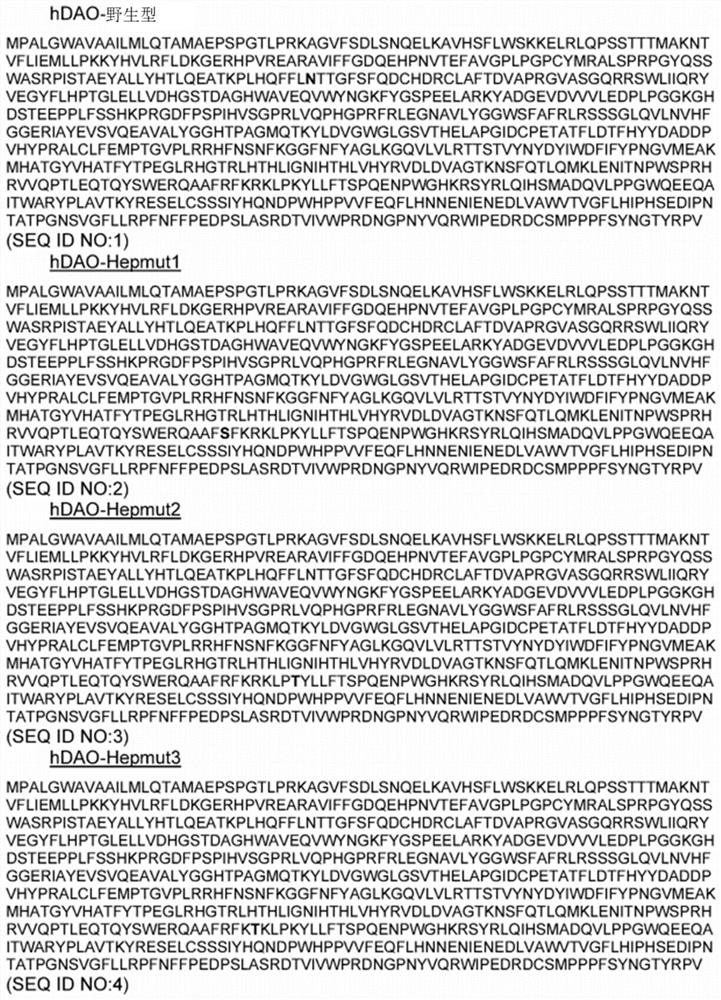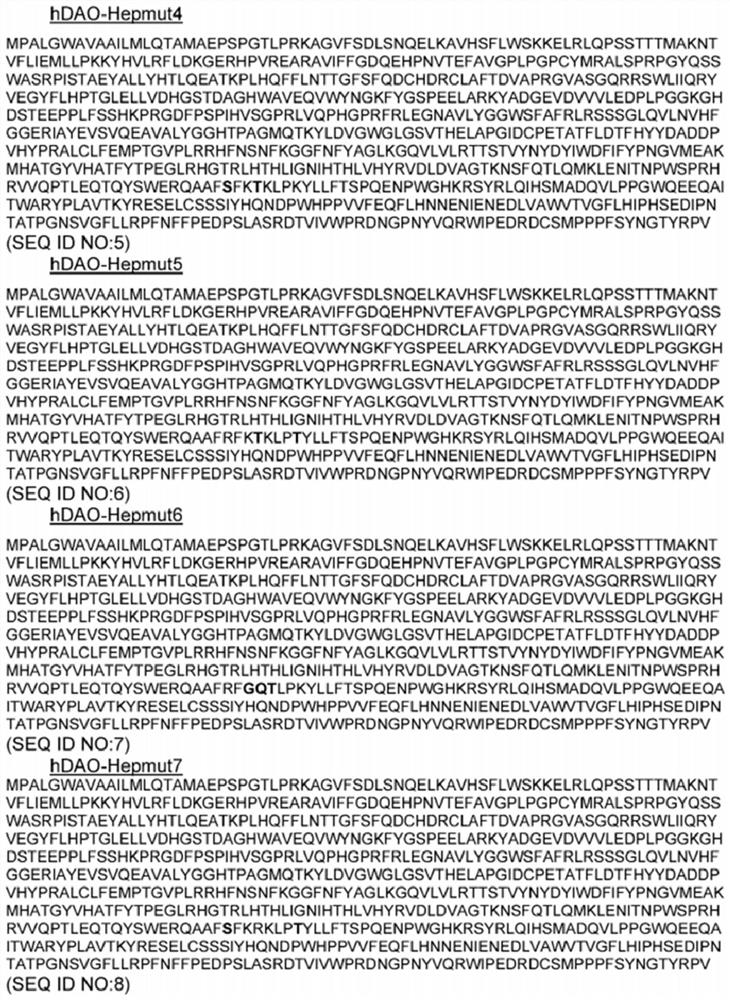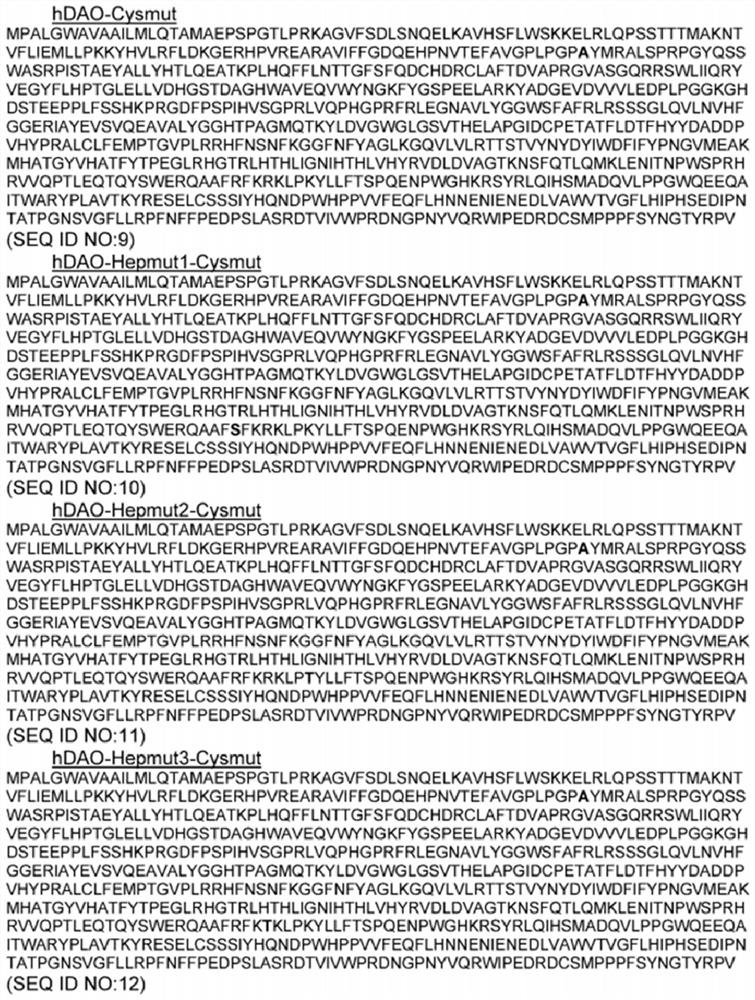New recombinant diamine oxidase and its use for the treatment of diseases characterized by excess histamine
A diamine oxidase, special technology, applied in allergic diseases, oxidoreductase, recombinant DNA technology, etc., can solve problems such as unmet needs
- Summary
- Abstract
- Description
- Claims
- Application Information
AI Technical Summary
Problems solved by technology
Method used
Image
Examples
Embodiment 1
[0254] DAOs with modified GAG binding domains:
[0255] Overview: Amino acid mutations in the GAG-binding (heparin / heparan sulfate-binding domain) of DAO. Following mutations in the heparin-binding domain of DAO, animal studies were performed with these mutants. In rats, the short alpha half-life can be nearly eliminated and the beta half-life increased to 6 hours. Alpha half-life refers to the rate of decrease in plasma concentration due to the process of drug redistribution from the central compartment to the peripheral compartment, and β half-life refers to the rate of decrease due to the process of drug elimination by metabolism or excretion. The area under the curve (AUC) increased more than 20-fold. The half-life of 6 hours in rats is extrapolated to 24 to 48 hours in humans, and this is certainly sufficient for the treatment of acute and subacute conditions with excess histamine. For example, anaphylaxis or MCAS events last from a few hours to 1 to 2 days, and in 1...
Embodiment 2
[0328] Fc-DAO with modified GAG binding domain:
[0329] Fc-DAO fusion variants were also tested with further improvements in heparin binding mutations and PK parameters with beta half-life of 9 hours and increased AUC. Amino acids involved in high-affinity interaction with Fc_γ receptors were removed, and amino acids involved in interaction with FcRN were not changed.
[0330] Intravenous injection of Fc-DAO_WT and Fc-DAO-Hepmut4 into rats
[0331] Below are the results using linear and log scales from 6 and 4 rats following iv injection of 1 mg / kg Fc-DAO wild type and Fc-Hepmut4 protein. We only use Fc-DAO wild type to measure 4 hours. Nevertheless, the derived exponential function can be used to extrapolate to 1680 minutes, as measured with the Fc-Hepmut4 variant (see below). Similar to the DAO wild-type protein, the Fc-DAO fusion protein exhibits a very rapid alpha distribution half-life. Most fusion variants were removed from plasma within 20 minutes. Afterwards, u...
Embodiment 3
[0349] DAO with modified GAG binding domain and modified cys123:
[0350] Cysteine 123 and 633 are not involved in the disulfide bond formation of the DAO dimer.
[0351] The relative accessible surface area or relative solvent accessibility (RSA) of protein residues is a measure of the solvent exposure of the residues. It can be calculated from the following formula: RSA=ASA / MaxASA, where ASA is the solvent-accessible surface area and MaxASA is the surface area of the largest possible solvent-accessible residue. Both ASA and MaxASA usually start with Measurement.
[0352] RSA Cys123
[0353] reachable / (monomer B)
[0354] reachable / (Monomer A), average = 62.4%
[0355] RSA Cys633
[0356]Cys633 = 34.62 accessible / 148 = 23.4% (monomer B)
[0357] Cys633 = 33.49 accessible / 148 = 22.6% (monomer A), average = 23%
[0358] Cys123 is on the surface, and this is unusual. The cysteine amino acid is the rarest and "least and highest" conserved amino acid in...
PUM
 Login to View More
Login to View More Abstract
Description
Claims
Application Information
 Login to View More
Login to View More - R&D
- Intellectual Property
- Life Sciences
- Materials
- Tech Scout
- Unparalleled Data Quality
- Higher Quality Content
- 60% Fewer Hallucinations
Browse by: Latest US Patents, China's latest patents, Technical Efficacy Thesaurus, Application Domain, Technology Topic, Popular Technical Reports.
© 2025 PatSnap. All rights reserved.Legal|Privacy policy|Modern Slavery Act Transparency Statement|Sitemap|About US| Contact US: help@patsnap.com



